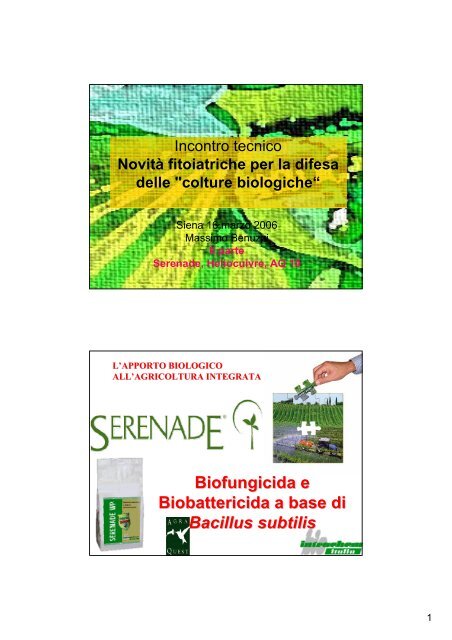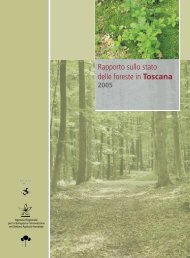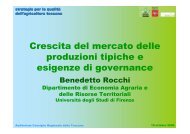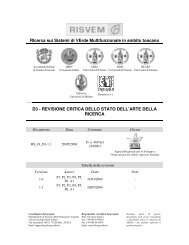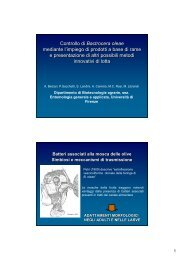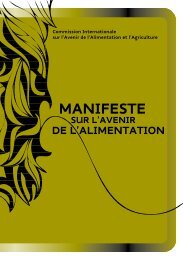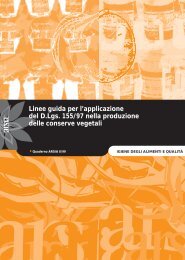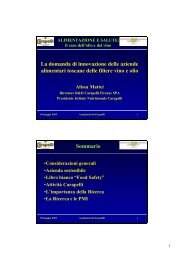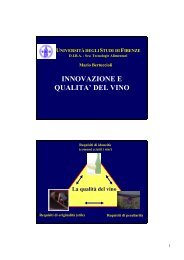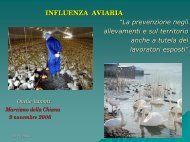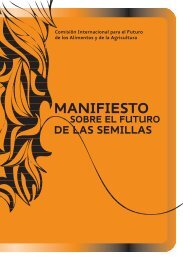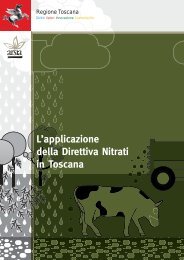SERENADE â Prodotto a base di Bacillus subtilis contro la ... - Arsia
SERENADE â Prodotto a base di Bacillus subtilis contro la ... - Arsia
SERENADE â Prodotto a base di Bacillus subtilis contro la ... - Arsia
Create successful ePaper yourself
Turn your PDF publications into a flip-book with our unique Google optimized e-Paper software.
In<strong>contro</strong> tecnico<br />
Novità fitoiatriche per <strong>la</strong> <strong>di</strong>fesa<br />
delle "colture biologiche“<br />
Siena 16 marzo 2006<br />
Massimo Benuzzi<br />
II parte<br />
Serenade, Heliocuivre, AQ 10<br />
L’APPORTO BIOLOGICO<br />
ALL’AGRICOLTURA AGRICOLTURA INTEGRATA<br />
Biofungicida e<br />
Biobattericida a <strong>base</strong> <strong>di</strong><br />
<strong>Bacillus</strong> <strong>subtilis</strong><br />
1
• Serenade è un biofungicida a <strong>base</strong> <strong>di</strong> <strong>Bacillus</strong><br />
<strong>subtilis</strong> (ceppo QST 713)<br />
• Si tratta <strong>di</strong> un ceppo che manifesta un’attivit<br />
attività<br />
antimicrobica superiore agli altri B.<strong>subtilis</strong> ed è<br />
brevettato<br />
• E’ prodotto negli USA da Agraquest<br />
• Il ceppo è stato iso<strong>la</strong>to da un pescheto a Fresno<br />
(California); non è un GMO<br />
• La formu<strong>la</strong>zione in polvere bagnabile contiene 5 x10 9<br />
cfu/g<br />
/g.<br />
• E’ ammesso in agricoltura biologica e certificato<br />
OMRI.<br />
• Il batterio B.<strong>subtilis</strong> è molto comune in tutti i<br />
suoli del mondo<br />
• Questo batterio in natura compete con altri<br />
microrganismi secernendo all’esterno del<strong>la</strong><br />
cellu<strong>la</strong> alcune sostanze<br />
• Si tratta <strong>di</strong> un meccanismo che si evoluto in<br />
modo da proteggere <strong>la</strong> nicchia ecologica del<br />
batterio inibendo lo sviluppo <strong>di</strong> potenziali<br />
competitori, sottraendo loro le fonti nutritive<br />
o anche eliminando i competitori<br />
<strong>di</strong>rettamente e utilizzandoli come fonte <strong>di</strong><br />
cibo<br />
2
• Serenade agisce preventivamente<br />
<strong>contro</strong> <strong>di</strong>verse crittogame<br />
– Può bloccare <strong>la</strong> germinazione delle spore<br />
fungine<br />
– Agire <strong>contro</strong> il tubetto germinativo e <strong>la</strong><br />
crescita del micelio<br />
– Inibire l’inse<strong>di</strong>amento l<br />
del patogeno sul<strong>la</strong><br />
foglia producendo una zona <strong>di</strong> inibizione<br />
che riduce <strong>la</strong> crescita del patogeno stesso<br />
• COME SI OTTIENE<br />
QUESTO RISULTATO <br />
3
Le spore <strong>di</strong> Serenade<br />
prevengono l’infezione del<br />
patogeno impedendo <strong>la</strong><br />
germinazione <strong>di</strong> quelle del<br />
patogeno tramite una zona <strong>di</strong><br />
inibizione<br />
patogeno<br />
fillop<strong>la</strong>no<br />
Durante il processo infettivo<br />
Serenade blocca <strong>la</strong><br />
germinazione delle spore del<br />
patogeno<br />
patogeno<br />
fillop<strong>la</strong>no<br />
4
Altera <strong>la</strong> crescita del<br />
patogeno perforando<br />
<strong>la</strong> membrana cellu<strong>la</strong>re<br />
del tubetto germinativo<br />
e del micelio<br />
patogeno<br />
fillop<strong>la</strong>no<br />
Come funziona <strong>SERENADE</strong><br />
Si applica come gli<br />
altri fungici<strong>di</strong><br />
Oi<strong>di</strong>o su una<br />
foglia non<br />
trattata<br />
Un nuovo modo <strong>di</strong> azione<br />
• Le spore <strong>di</strong> <strong>di</strong>Serenade coprono<br />
il ilfillop<strong>la</strong>no e prevengono le<br />
le<br />
penetrazioni fungine e le<br />
le<br />
successive infezioni al<strong>la</strong><br />
pianta.<br />
• I I Lipopepti<strong>di</strong> contenuti in<br />
in<br />
Serenade rompono le le cellule<br />
del patogeno causandone il<br />
il<br />
col<strong>la</strong>sso e <strong>la</strong> <strong>la</strong> morte.<br />
• I I lipopepti<strong>di</strong> impe<strong>di</strong>scono ai<br />
ai<br />
batteri patogeni <strong>di</strong><br />
<strong>di</strong><br />
moltiplicarsi<br />
Serenade <strong>di</strong>strugge le spore<br />
germinanti<br />
5
Come funziona<br />
<strong>SERENADE</strong><br />
Botrytis 0% inibizione<br />
Non trattato con<br />
Serenade<br />
Botrytis ~100% inibizione<br />
Trattato con Serenade<br />
Dettaglio dei “principi attivi” <strong>di</strong> <strong>SERENADE</strong><br />
I lipopepti<strong>di</strong> agiscono sinergicamente nel contenimento dei<br />
RT:0.01 - 30.01<br />
100<br />
90<br />
80<br />
Iturine<br />
7.47<br />
8.88<br />
patogeni<br />
Surfactine<br />
24.58<br />
NL:<br />
1.07E8<br />
Base Peak<br />
F: + c Full<br />
ms<br />
70<br />
Re<strong>la</strong>tive Abundance<br />
60<br />
50<br />
40<br />
30<br />
20<br />
10<br />
0<br />
1.66<br />
10.91<br />
Agrastatine/<br />
Plipastatine<br />
11.22<br />
9.30<br />
19.02 20.10<br />
17.79<br />
6.27<br />
20.19<br />
11.92<br />
5.50 16.75<br />
15.41<br />
4.93 12.62<br />
3.73<br />
2 4 6 8 10 12 14 16 18 20 22 24 26 28 30<br />
Time (min)<br />
23.80<br />
23.52<br />
25.71<br />
26.90<br />
28.93<br />
6
Serenade quin<strong>di</strong> agisce con <strong>di</strong>verse<br />
modalità<br />
• Compete con altri microrganismi per le<br />
fonti nutritive e lo spazio<br />
• Produce tre <strong>di</strong>versi tipi <strong>di</strong> lipopepti<strong>di</strong>:<br />
– Iturine<br />
– Agrastatine/Plipastatine<br />
– Surfactine<br />
• I Lipopepti<strong>di</strong> con un’azione sinergica dovuta al<strong>la</strong><br />
compresenza <strong>di</strong> DIVERSE sostanze inibiscono le<br />
crescita del tubetto germinativo, del micelio fungino<br />
e <strong>la</strong> moltiplicazione delle cellule batteriche.<br />
• Il ceppo <strong>di</strong> B.<strong>subtilis</strong> QST 713 è l’unico a possedere<br />
una nuova combinazione <strong>di</strong> 3 lipopepti<strong>di</strong>, , tra cui uno<br />
assolutamente nuovo e caratterizzato da una<br />
partico<strong>la</strong>re sequenza aminoaci<strong>di</strong>ca (agrastatine).<br />
• Le surfactine e le agrastatine non hanno alcuna<br />
attività se saggiate da sole, ma misce<strong>la</strong>te (e a bassi<br />
livelli, 10 ppm o anche meno)con le iturine agiscono<br />
come forti inibitori biologici per <strong>di</strong>versi<br />
microrganismi.<br />
7
Spettro <strong>di</strong> attività<br />
Serenade ha un ampio spettro <strong>di</strong> attività:<br />
• Botrytis cinerea e marciume acido<br />
• Diversi oi<strong>di</strong><br />
• Fire blight e altre batteriosi (Xanthomonas<br />
spp.)<br />
• Sclerotinia<br />
• Ticchio<strong>la</strong>tura<br />
• Altre crittogame in corso <strong>di</strong> valutazione<br />
COME SI APPLICA<br />
8
ampio<br />
spettro <strong>di</strong> azione e preventivo, che può<br />
• Serenade è un biofungicida ad ampio<br />
essere applicato in 3 <strong>di</strong>versi mo<strong>di</strong>:<br />
1. Trattamento fogliare da solo<br />
2. Trattamento fogliare alternato a fungici<strong>di</strong><br />
convenzionali in un programma <strong>di</strong> <strong>di</strong>fesa<br />
integrato<br />
3. Trattamento fogliare in misce<strong>la</strong> con altri fungici<strong>di</strong><br />
( AD ESEMPIO I RAMEICI A BASSE DOSI)<br />
Dosaggio:<br />
– 2-33 kg/Ha (250-350 g/hl)<br />
– + un bagnante (pinolene(<br />
pinolene)<br />
9
Miscibilità:<br />
– Serenade è miscibile con i concimi fogliari<br />
e molti insettici<strong>di</strong> e fungici<strong>di</strong><br />
– Il pH del<strong>la</strong> sospensione deve essere tra 4,5<br />
e 8,5<br />
Conservazione:<br />
3 anni a temperatura ambiente<br />
10
Vantaggi tecnici:<br />
1. Largo spettro <strong>di</strong> azione<br />
2. Azione secondaria su molte crittogame<br />
3. Elevate possibilità <strong>di</strong> miscele<br />
4. Meno problemi con le basse T°<br />
5. Facilità <strong>di</strong> stoccaggio<br />
6. Integrazione in programmi<br />
antiresistenza<br />
Strategia antibotritica su vite da vino<br />
A<br />
Fine<br />
fioritura<br />
B.<strong>subtilis</strong><br />
B<br />
C<br />
prechiusura<br />
invaiatura<br />
B.<strong>subtilis</strong><br />
B.<strong>subtilis</strong><br />
Posizionamento<br />
in agricoltura<br />
biologica<br />
D<br />
preraccolta<br />
B.<strong>subtilis</strong><br />
11
Servizio tecnico<br />
Prove <strong>contro</strong><br />
botrite/marciume<br />
acido su vite<br />
- Centro <strong>di</strong> Saggio: G.Z. srl – coltura: vite – Cv.Pinot Grigio –<br />
località: Ponte <strong>di</strong> Piave (TV) - anno 2004<br />
tesi<br />
dosaggio<br />
trattamenti<br />
Efficacia %<br />
Testimone<br />
---<br />
---<br />
---<br />
B.<strong>subtilis</strong><br />
250 g/hl<br />
ABCD<br />
59,37<br />
Cypro<strong>di</strong>nil +flu<strong>di</strong>oxonil<br />
80 g/hl<br />
BCD<br />
79,68<br />
Pyrimetanil<br />
150 cc/hl<br />
BCD<br />
75,78<br />
12
Prova 1 - Grado <strong>di</strong> efficacia <strong>di</strong> Serenade nei confronti del<strong>la</strong> Botrite<br />
(Botritis cinerea ) e del marciume acido dell'uva da vino - 2004<br />
(%)<br />
100<br />
90<br />
80<br />
70<br />
60<br />
50<br />
40<br />
30<br />
20<br />
10<br />
0<br />
59,4<br />
Serenade 250 g/hl: 4 tratt.<br />
fasi A, B, C, D<br />
79,7<br />
Switch 80 cc/hl: 3 tratt. fasi<br />
B, C, D<br />
75,8<br />
Sca<strong>la</strong> 150 cc/hl: 3 tratt. fasi<br />
B, C, D<br />
- Centro <strong>di</strong> Saggio: Viten – coltura: vite – Cv.Moscato –<br />
località: Calosso (AT) - anno 2004<br />
tesi<br />
dosaggio<br />
trattamenti<br />
Testimone<br />
---<br />
---<br />
B.<strong>subtilis</strong><br />
350 g/hl<br />
ABCD<br />
Switch/Sca<strong>la</strong><br />
80/150 g/hl<br />
B/C<br />
13
Risultati su B. cinerea sui grappoli: 17/09/04<br />
100<br />
a<br />
86,0<br />
90<br />
80<br />
b<br />
70<br />
%<br />
60<br />
50<br />
40<br />
30<br />
20<br />
10<br />
a<br />
24,6<br />
3,4<br />
b<br />
6,2<br />
24,0<br />
42,5<br />
0<br />
Severity % Incidence %<br />
Control Switch/Teldor Serenade 350 g/hl<br />
Means followed by some letter do not significantly <strong>di</strong>ffer (P=0,05 Duncan)<br />
Risultati su Botrytis cinerea : 17/09/04<br />
Effect % (Abbott)<br />
86,3<br />
%<br />
100<br />
90<br />
80<br />
70<br />
60<br />
50<br />
40<br />
30<br />
20<br />
10<br />
0<br />
Severity<br />
74,7 72,1<br />
Incidence<br />
50,6<br />
Switch/Teldor<br />
Serenade 350 g/hl<br />
14
Risultati su Marciume acido sui grappoli:17/09/04<br />
100<br />
90<br />
80<br />
70<br />
%<br />
60<br />
50<br />
a<br />
47,0<br />
ab<br />
40<br />
30<br />
a<br />
21,0<br />
23,5<br />
20<br />
10<br />
4,7 1,9 1,9<br />
0<br />
Severity % Diffusion %<br />
Control Switch/Teldor Serenade 350 g/hl<br />
Means followed by some letter do not significantly <strong>di</strong>ffer (P=0,05 Duncan)<br />
Risultati sul Marciume acido: 17/09/04<br />
Effect % (Abbott)<br />
%<br />
100<br />
90<br />
80<br />
70<br />
60<br />
50<br />
40<br />
30<br />
20<br />
10<br />
0<br />
59,9<br />
Infection<br />
59,2<br />
55,3<br />
Diffusion<br />
50,0<br />
Switch/Teldor<br />
Serenade 350 g/hl<br />
15
- Centro <strong>di</strong> Saggio: Sagea – coltura: vite – Cv.Moscato –<br />
località: Cassano Belbo (CN) - anno 2004<br />
tesi<br />
dosaggio<br />
trattamenti<br />
Testimone<br />
B.<strong>subtilis</strong><br />
---<br />
350 g/hl<br />
---<br />
ABCD<br />
Switch/Teldor<br />
80/150<br />
B/D<br />
Risultati su Botrytis cinerea (23/09/04)<br />
50<br />
43,9 a<br />
% of attacked<br />
40<br />
30<br />
20<br />
10<br />
26,2 a<br />
19,8 a<br />
0<br />
Infection %<br />
Control Serenade 350 g/hl Switch 80 g/hl / Teldor 150 g/hl<br />
Means followed by some letter do not significantly <strong>di</strong>ffer (P=0,05 Tukey)<br />
16
Risultati su B. cinerea (23/9/04)<br />
Effect % (Abbott)<br />
%<br />
100<br />
90<br />
80<br />
70<br />
60<br />
50<br />
40<br />
30<br />
20<br />
10<br />
0<br />
40,3<br />
Infection<br />
54,9<br />
Serenade 350 g/hl<br />
Switch 80 g/hl / Teldor 150 g/hl<br />
%<br />
50<br />
45<br />
40<br />
35<br />
30<br />
25<br />
20<br />
15<br />
10<br />
5<br />
0<br />
Risultati su Marciume acido (23/09/04)<br />
49 a<br />
38 a<br />
18,4 a<br />
6,6 a 7,2 a<br />
Infection % Diffusion %<br />
39 a<br />
Control Serenade 350 g/hl Switch 80 g/hl / Teldor 150 g/hl<br />
Mens followed by some letter do not significantly <strong>di</strong>ffer (P=0,05 Tukey)<br />
17
Risultati su Marciume acido (23/9/04)<br />
Effect % (Abbott)<br />
%<br />
100<br />
90<br />
80<br />
70<br />
60<br />
50<br />
40<br />
30<br />
20<br />
10<br />
0<br />
64,3<br />
Infection<br />
61,0<br />
22,4 20,4<br />
Diffusion<br />
Serenade 350 g/hl<br />
Switch 80 g/hl / Teldor 150 g/hl<br />
• Crop: Vineyard (Pinot grigio)<br />
• Target: Botrytis and Sour Rot<br />
• Site: Ponte <strong>di</strong> Piave (TV)<br />
• Products: Serenade Max, Switch (Cypro<strong>di</strong>nil<br />
37,5% + Flu<strong>di</strong>oxonil 25% WG), Sca<strong>la</strong> (Pyrimethanil 37,5%)<br />
• Partner: G.Z. Srl<br />
18
• Trial n°4<br />
N°<br />
Product<br />
Rate g/hl<br />
treatments<br />
1<br />
Control<br />
2<br />
Serenade<br />
Max<br />
250<br />
4: 23/6 (A), 3/7 (B), 4/8<br />
(C), 16/8 (D)<br />
3<br />
Switch<br />
80<br />
3:3/7 (B), 4/8 (C), 16/8<br />
(D)<br />
4<br />
Sca<strong>la</strong><br />
150<br />
3:3/7 (B), 4/8 (C), 16/8<br />
(D)<br />
Results on Botrytis cinerea:<br />
trial n°4 (30/08/04)<br />
% of attacked<br />
20<br />
15<br />
10<br />
5<br />
0<br />
16 a<br />
6,5 b<br />
Severity<br />
0,8 b 0,8 b<br />
Control Serenade Max 250 g/hl Switch 80 g/hl Sca<strong>la</strong> 150 cc/hl<br />
Means followed by some letter do not significantly <strong>di</strong>ffer (P=0,05 Duncan)<br />
19
Results on B. cinerea: trial n°4<br />
(30/8/04)<br />
Effect % (Abbott)<br />
95,3 95,3<br />
%<br />
100<br />
90<br />
80<br />
70<br />
60<br />
50<br />
40<br />
30<br />
20<br />
10<br />
0<br />
59,4<br />
Serenade 250 g/hl Switch 80 g/hl Sca<strong>la</strong> 150 g/hl<br />
Results on Sour rot:<br />
trial n°4 (30/08/04)<br />
20<br />
16 a<br />
% of<br />
attacked<br />
15<br />
10<br />
5<br />
4 b<br />
5,8 b<br />
7 b<br />
0<br />
Severity<br />
Control Serenade 350 g/hl Switch 80 g/hl Sca<strong>la</strong> 150 cc/hl<br />
Means followed by some letter do not significantly <strong>di</strong>ffer (P=0,05 Duncan)<br />
20
Results on Sour rot: trial n°4<br />
(30/08/04)<br />
Effect % (Abbott)<br />
%<br />
100<br />
90<br />
80<br />
70<br />
60<br />
50<br />
40<br />
30<br />
20<br />
10<br />
0<br />
75,0<br />
64,1<br />
56,3<br />
Serenade 350 g/hl Switch 80 g/hl Sca<strong>la</strong> 150 g/hl<br />
Prove <strong>di</strong> efficacia<br />
Serenade - 2005<br />
21
3<br />
Azienda<br />
Coltura, varietà<br />
Forma <strong>di</strong> allevamento<br />
Sesto d’impianto<br />
Disegno sperimentale<br />
Consorzio Agrario <strong>di</strong> Ravenna<br />
Soc. coop. a.r.l.<br />
Montone, Godo <strong>di</strong> Russi (Ravenna)<br />
uva da vino, Trebbiano<br />
casarsa<br />
3,5 x 1,2 m<br />
blocchi randomizzati (4 rep. da 10 viti)<br />
Tesi a confronto<br />
1. Serenade (350 g/hl) in B, C, D<br />
2. Serenade (250 g/hl) in B, C, D<br />
3. Switch (80 g/hl) in B; Serenade (250 g/hl) in C, D<br />
4. Switch (80 g/hl) in B<br />
5. Switch (80 g/hl) in B, C<br />
6. Testimone<br />
3<br />
100<br />
90<br />
80<br />
70<br />
Consorzio Agrario <strong>di</strong> Ravenna<br />
Soc. coop. a.r.l.<br />
BOTRITE: INCIDENZA & GRAVITA’<br />
(20 Settembre 2005)<br />
Serenade 350 g/hl (BCD)<br />
Serenade 250 g/hl (BCD)<br />
Switch (B)+Serenade 250 g/hl (CD)<br />
Switch (B)<br />
Switch (BC)<br />
Untreated <strong>contro</strong>l<br />
60<br />
(%)<br />
50<br />
40<br />
37.5<br />
c<br />
30<br />
20<br />
10<br />
0<br />
18.5<br />
ab<br />
21.5<br />
b<br />
19.0<br />
13.5 ab<br />
ab 8.5<br />
8.0<br />
6.3<br />
8.0<br />
a<br />
B<br />
5.0<br />
AB<br />
B<br />
AB<br />
Incidence<br />
Severity<br />
Lettere <strong>di</strong>verse in<strong>di</strong>cano <strong>di</strong>fferenze statisticamente significative (Duncan’s test: P
• Su vite: 250-350 g/hl (corrispondenti a 3 kg/ha) <strong>contro</strong> <strong>la</strong><br />
Muffa grigia e il Marciume acido.<br />
• La <strong>di</strong>fesa con Serenade può essere impostata con una<br />
serie <strong>di</strong> 3-4 trattamenti nelle fasi <strong>di</strong> fine fioritura, prechiusura<br />
grappolo, invaiatura e preraccolta.<br />
• In una strategia <strong>di</strong> lotta integrata Serenade può essere<br />
applicato in combinazione con i tra<strong>di</strong>zionali fungici<strong>di</strong> <strong>di</strong><br />
sintesi, trovando partico<strong>la</strong>re vantaggio nelle applicazioni<br />
<strong>di</strong> fine fioritura e dall’invaiatura fino al<strong>la</strong> raccolta.<br />
Serenade infatti non interferisce assolutamente con i<br />
processi <strong>di</strong> fermentazione alcolica per cui può essere<br />
utilizzato, specialmente <strong>contro</strong> il Marciume Acido, fino in<br />
prossimità del<strong>la</strong> vendemmia.<br />
HELIOCUIVRE<br />
Registrazione N° 12270 del 16.04.04<br />
23
Fungici<strong>di</strong> a <strong>base</strong> terpenica<br />
• I terpeni sono sostanze naturali<br />
estratte a vapore dal legno <strong>di</strong><br />
conifere<br />
• I terpeni costituiscono una novità<br />
per <strong>la</strong> formu<strong>la</strong>zione degli<br />
agrofarmaci<br />
Fungici<strong>di</strong> a <strong>base</strong> terpenica<br />
• I Terpeni migliorano <strong>la</strong> qualità del<br />
trattamento<br />
• I Terpeni ottimizzano <strong>la</strong> <strong>di</strong>mensione<br />
delle particelle che fuoriescono<br />
dall'atomizzatore:<br />
►Copertura<br />
migliorata del<strong>la</strong> coltura<br />
►Riduzione<br />
del<strong>la</strong> deriva<br />
►Incremento<br />
del<strong>la</strong> bagnatura<br />
► Riducono il <strong>di</strong><strong>la</strong>vamento con incremento<br />
del<strong>la</strong> persistenza<br />
24
Ottimizza <strong>la</strong> qualità del<strong>la</strong> polverizzazione del trattamento<br />
12<br />
Comparazione del<strong>la</strong> granulométria tra Héliocuivre e un prodotto rameico tra<strong>di</strong>zionale<br />
Héliocuivre : 55% <strong>di</strong> gocce "efficaci"<br />
<strong>Prodotto</strong> rameico : 48% <strong>di</strong> gocce "efficaci"<br />
10<br />
% delle gocce per c<strong>la</strong>sse<br />
8<br />
6<br />
4<br />
2<br />
Heliocuivre<br />
<strong>Prodotto</strong> rameico<br />
0<br />
20 60 100 140 180 220 260 300 340 380 420 460 500 540 580<br />
Taglia delle goccioline<br />
La maggior parte delle gocce è compresa nelle zone tra 100-250 µ, così da permettere a<br />
Héliocuivre <strong>di</strong> ripartirsi al meglio sulle foglie e limitare molto <strong>la</strong> deriva (gocce<br />
inferiori a 80 µ)<br />
HELIOCUIVRE<br />
Trattamento tra<strong>di</strong>zionale<br />
Trattamento con Heliocuivre<br />
25
HELIOCUIVRE<br />
il l Rame <strong>di</strong> nuova generazione<br />
•Il<br />
principio attivo è l'idrossido<br />
<strong>di</strong> rame al<br />
40%: Cu(OH)<br />
2<br />
•Forma<br />
dei cristalli rameici: piccole<br />
scaglie<br />
•Dimensioni<br />
dei cristalli: attorno ai 0,55<br />
µm<br />
HELIOCUIVRE<br />
il l Rame <strong>di</strong> nuova generazione<br />
26
HELIOCUIVRE<br />
il l Rame <strong>di</strong> nuova generazione<br />
Attività sperimentale<br />
HELIOCUIVRE<br />
il l Rame <strong>di</strong> nuova generazione<br />
PROVA SU MOSCATO -VITEN CALOSSO (AT)<br />
ANNO 2003<br />
Nr. Product Rates g-ml/ha f.p. Name a.i. A.i.g/kg-l Rates g-ml/ha a.i. Applications<br />
N° <strong>Prodotto</strong> Dosaggio p.f. Nome p.a. P.a. g/kg-l Dosaggio . Applicazioni<br />
1 UNTREATED - - - - -<br />
2 Poltiglia Disperss 6.000 rame 200 1200 ABCDEFGHILMN<br />
3 Heliocouivre 1.250 - - - ABCDEFGHILMN<br />
4 Heliocouivre 1.250 + - - -<br />
+Gro stim 1.000 - - - ABCDEFGHILMN<br />
5 Heliocouivre 750 + - - -<br />
+Gro stim 1.000 - - - ABCDEFGHILMN<br />
6 Gro stim 3.000 - - - ABCDEFGHILMN<br />
7 Kendal 3.000 - - - ABCDEFGHILMN<br />
8 LG36/02 3.000 - - - ABCDEFGHILMN<br />
9 Poltiglia Disperss 2.000 + rame 200 400<br />
+Kendal 3.000 - - - ABCDEFGHILMN<br />
27
HELIOCUIVRE<br />
il l Rame <strong>di</strong> nuova generazione<br />
HELIOCUIVRE<br />
il l Rame <strong>di</strong> nuova generazione<br />
28
HELIOCUIVRE<br />
il l Rame <strong>di</strong> nuova generazione<br />
RISULTATI SUL GRAPPOLO<br />
Nr. Products<br />
29/07/2003<br />
infection % Duncan effect <strong>di</strong>ffusion % Duncan effect<br />
1 Untreated 8,74 a A 0,0 62,4 a A 0,0<br />
2 Disperss 0,23 b B 97,4 5,6 c C 91,0<br />
3 Heliocouivre 0,69 b B 92,1 13,8 c BC 78,0<br />
4 Heliocouivre + Gro Stim 0,62 b B 92,9 9,4 c C 85,0<br />
5 Heliocouivre + Gro Stim 0,46 b B 94,8 8,0 c C 87,2<br />
6 Gro Stim 0,48 b B 94,6 9,6 c C 84,7<br />
7 Kendal 2,42 b B 72,4 32,7 b B 47,6<br />
8 Fosfito 1,18 b B 86,5 15,6 c BC 74,9<br />
9 Disperss + Kendal 0,06 b B 99,4 1,3 c C 97,9<br />
HELIOCUIVRE<br />
il l Rame <strong>di</strong> nuova generazione<br />
29
Prove Servizio fitosanitario<br />
del Veneto – 2005- vite<br />
Tesi<br />
<strong>Prodotto</strong> formu<strong>la</strong>to<br />
(p.f.)<br />
Sostanza attiva (s.a.) Formu<strong>la</strong>zione<br />
Cu ++ /p.f<br />
.<br />
p.f./h<br />
L<br />
Cu ++<br />
gr/hL<br />
1<br />
Testimone<br />
-<br />
-<br />
2<br />
Airone<br />
Rame Ossicloruro e Idrossido<br />
SC<br />
272 g/l<br />
250 ml<br />
68<br />
3<br />
Poltiglia Caffaro 20<br />
DF<br />
Rame da Solfato<br />
WG<br />
20%<br />
500 g<br />
100<br />
4<br />
Poltiglia Disperss<br />
Rame da Idrossisolfato<br />
WG<br />
20%<br />
500 g<br />
100<br />
5<br />
Cuprocaffaro Micro<br />
Rame Ossicloruro<br />
WG<br />
37,5 %<br />
300 g<br />
112,5<br />
6<br />
Kocide 2000<br />
Rame Idrossido<br />
DF<br />
35%<br />
200 g<br />
70<br />
7<br />
Kocide Gold<br />
Rame Idrossido<br />
DF<br />
15%<br />
300 g<br />
45<br />
8<br />
Heliocuivre<br />
Rame Idrossido<br />
SC<br />
400 g/l<br />
125<br />
ml<br />
50<br />
Eseguire trattamenti preventivi a partire da quando si verificano le con<strong>di</strong>zioni pre<strong>di</strong>sponenti l’infezione primaria e procedere con<br />
intervalli <strong>di</strong> 7-8 giorni.<br />
Prove Servizio fitosanitario del Veneto – 2005- vite<br />
Risultati<br />
DATA<br />
T<br />
E<br />
S<br />
I<br />
I%I<br />
Duncan<br />
FOGLIE<br />
I%D<br />
I%E<br />
I%I<br />
GRAPPOLI<br />
Duncan<br />
I%D<br />
I%E<br />
20-7<br />
1<br />
8,43<br />
-<br />
-<br />
27,50<br />
-<br />
1,75<br />
-<br />
-<br />
7,00<br />
-<br />
1<br />
25,79<br />
a<br />
A<br />
70,75<br />
-<br />
21,97<br />
a<br />
A<br />
63,75<br />
-<br />
2<br />
2,54<br />
b<br />
B<br />
8,75<br />
90,16<br />
1,79<br />
b<br />
B<br />
10,25<br />
91,86<br />
3<br />
1,89<br />
b<br />
B<br />
5,75<br />
92,66<br />
2,18<br />
b<br />
B<br />
13,50<br />
90,09<br />
26-7<br />
4<br />
5<br />
2,18<br />
2,72<br />
b<br />
b<br />
B<br />
B<br />
6,50<br />
7,50<br />
91,55<br />
89,47<br />
1,64<br />
2,11<br />
b<br />
b<br />
B<br />
B<br />
8,75<br />
11,25<br />
92,52<br />
90,41<br />
6<br />
2,07<br />
b<br />
B<br />
6,75<br />
91,97<br />
2,22<br />
b<br />
B<br />
11,50<br />
89,90<br />
7<br />
3,36<br />
b<br />
B<br />
9,75<br />
86,98<br />
2,93<br />
b<br />
B<br />
14,00<br />
86,66<br />
8<br />
1,61<br />
b<br />
B<br />
5,25<br />
93,77<br />
2,18<br />
b<br />
B<br />
10,75<br />
90,08<br />
30
Prove Servizio fitosanitario del Veneto – 2005- vite<br />
Risultati<br />
Quantità <strong>di</strong> rame per ettaro <strong>di</strong>stribuite sulle <strong>di</strong>verse tesi e<br />
re<strong>la</strong>tivi I%I finale<br />
Tes<br />
i<br />
<strong>Prodotto</strong> formu<strong>la</strong>to (p.f.)<br />
Sostanza attiva (s.a.) Formu<strong>la</strong>zione<br />
Cu ++<br />
kg/ha<br />
I%I<br />
foglie<br />
I%I<br />
grappoli<br />
1<br />
Testimone non trattato<br />
25,79<br />
21,97<br />
2<br />
Airone<br />
Rame Ossicloruro e Idrossido<br />
SC<br />
8,9<br />
2,54<br />
1,79<br />
3<br />
Poltiglia Caffaro 20 DF<br />
Rame da Solfato<br />
WG<br />
13,1<br />
1,89<br />
2,18<br />
4<br />
Poltiglia Disperss<br />
Rame da Idrossisolfato<br />
WG<br />
13,1<br />
2,18<br />
1,64<br />
5<br />
Cuprocaffaro Micro<br />
Rame Ossicloruro<br />
WG<br />
14,7<br />
2,72<br />
2,11<br />
6<br />
Kocide 2000<br />
Rame Idrossido<br />
DF<br />
9,2<br />
2,07<br />
2,22<br />
7<br />
Kocide Gold<br />
Rame Idrossido<br />
DF<br />
5,9<br />
3,36<br />
2,93<br />
8<br />
Heliocuivre<br />
Rame Idrossido<br />
SC<br />
5,9<br />
1,61<br />
2,18<br />
HELIOCUIVRE<br />
il l Rame <strong>di</strong> nuova generazione<br />
•Héliocuivre<br />
non ha effetti<br />
negativi :<br />
–Sul<strong>la</strong><br />
maturazione dell'uva<br />
–Sul<strong>la</strong><br />
fermentazione alcolica e su<br />
quel<strong>la</strong> malo<strong>la</strong>ttica<br />
–Sul<br />
sapore e sul<strong>la</strong> qualità<br />
enologica del vino<br />
31
HELIOCUIVRE<br />
il l Rame <strong>di</strong> nuova generazione<br />
VANTAGGI<br />
•Riduzione sostanziale dell'apporto <strong>di</strong><br />
rame metallo (50-60 g/hl)<br />
•Incremento dell'efficacia del rame<br />
<strong>di</strong>stribuito<br />
•Aumento del<strong>la</strong> copertura del<strong>la</strong><br />
vegetazione trattata<br />
•Riduzione del <strong>di</strong><strong>la</strong>vamento<br />
•Basso rischio <strong>di</strong> fitotossicità<br />
IL PRIMO<br />
BIOFUNGICIDA<br />
MICROBIOLOGICO<br />
CONTRO L’OIDIOL<br />
L’APPORTO BIOLOGICO<br />
ALL’AGRICOLTURA AGRICOLTURA INTEGRATA<br />
32
• è il primo biofungicida per il <strong>contro</strong>llo<br />
biologico dell’oi<strong>di</strong>o<br />
• a <strong>base</strong> del microrganismo<br />
Ampelomyces quisqualis<br />
• è un fungo Deuteromicete del<strong>la</strong> famiglia<br />
Dematiacee descritto da più <strong>di</strong> 140 anni<br />
che vive a spese <strong>di</strong> Erysiphales (gli<br />
oi<strong>di</strong>i)<br />
Modo <strong>di</strong> azione<br />
33
oi<strong>di</strong>o non trattato<br />
oi<strong>di</strong>o trattato con<br />
Come si applica su vite da vino:<br />
• dose: 30-3535 gr/ha<br />
• deve essere sempre misce<strong>la</strong>to con olio<br />
estivo allo 0,1-0,2 % (UFO o ULTRA-CITRUS)<br />
• trattare nelle prime ore del giorno o al<strong>la</strong> sera<br />
• ad intervalli <strong>di</strong> 7-10 giorni<br />
• È opportuno eseguire almeno 2 trattamenti<br />
consecutivi<br />
• curare <strong>la</strong> bagnatura del<strong>la</strong> vegetazione<br />
34
TRATTAMENTI FONDAMENTALI<br />
• dal germogliamento al<strong>la</strong> fioritura<br />
• da chiusura grappolo a invaiatura<br />
Per il <strong>contro</strong>llo delle<br />
infezioni sul<strong>la</strong> vegetazione<br />
TRATTAMENTI CONSIGLIATI<br />
• prevendemmia<br />
• postvendemmia<br />
Per il <strong>contro</strong>llo<br />
dei cleistoteci<br />
35
Calendario per Agricoltura<br />
Biologica<br />
Da rottura<br />
gemme<br />
Da fioritura<br />
a chiusura<br />
Da chiusura<br />
grappolo<br />
Prevendemmia<br />
Postvendemmia<br />
a fioritura<br />
grappolo<br />
a invaiatura<br />
HELIOSOUFRE<br />
HELIOSOUFRE<br />
HELIOSOUFRE<br />
Prove Cleistoteci anno 2002<br />
• Az. Agrico<strong>la</strong> Bevacqua Fara <strong>di</strong> Soligo (TV)<br />
• Vitigno: prosecco<br />
• Forma <strong>di</strong> allevamento: Capovolto<br />
• Sesto <strong>di</strong> impianto: 1 x 4 metri<br />
• Vendemmia: 26 settembre<br />
• Piano sperimentale: parcelloni da 5000 m 2<br />
36
Prove Cleistoteci anno 2002<br />
• Programma <strong>di</strong>fesa antioi<strong>di</strong>ca<br />
• 2 trattamenti con Dinocap<br />
• 3 trattamenti con Quinoxifen<br />
• Trattamenti con zolfo ogni 10 gg<br />
Prove Cleistoteci anno 2002<br />
Tesi impostate<br />
N° tesi<br />
<strong>Prodotto</strong><br />
dosaggio<br />
Date trattamenti<br />
1<br />
AQ 10<br />
+ UFO<br />
35 g/Ha +<br />
0,1 %<br />
14 set.<br />
18 ott.<br />
2<br />
AQ 10<br />
+ UFO<br />
35 g/Ha +<br />
0,1 %<br />
14 set.<br />
9 ott.<br />
18 ott.<br />
3<br />
NON<br />
TRATTATO<br />
-<br />
-<br />
-<br />
37
Prove Cleistoteci anno 2002<br />
Conteggio dei cleistoteci<br />
• 7 prelievi dal 26/9 <strong>di</strong> 10-15 foglie ogni 7-9<br />
giorni<br />
• Imbutini <strong>di</strong> carta da filtro (12/pianta) con <strong>la</strong><br />
stessa frequenza del campionamento<br />
delle foglie<br />
• Cleistoteci <strong>di</strong>stinti in:<br />
– Gialli --> giovani<br />
– Marroni --> interme<strong>di</strong><br />
– Neri -->maturi<br />
Inoltre sono stati effettuati<br />
<strong>contro</strong>lli con <strong>la</strong> fluorescina<br />
<strong>di</strong>acetato<br />
Prove Cleistoteci anno 2002<br />
• Intensità ed incidenza<br />
dell'infezione dell'oi<strong>di</strong>o<br />
tesi<br />
0<br />
1<br />
2<br />
% infezione<br />
44,6<br />
45,6<br />
% <strong>di</strong>ffusione<br />
85,3<br />
92,1<br />
38
Prove Cleistoteci anno 2002<br />
• Risultati: N° complessivo <strong>di</strong> cleistoteci osservati<br />
sulle foglie nelle <strong>di</strong>verse tesi<br />
140.000<br />
110.000<br />
138.364<br />
80.000<br />
50.000<br />
85.209<br />
N°totale cleistoteci<br />
69.904<br />
non trattato tesi 1 tesi 2<br />
Prove Cleistoteci anno 2002<br />
Andamento del numero <strong>di</strong> cleistoteci su foglie delle<br />
<strong>di</strong>verse tesi<br />
40.000<br />
35.000<br />
30.000<br />
25.000<br />
20.000<br />
15.000<br />
10.000<br />
5.000<br />
0<br />
Trattamenti con AQ 10<br />
26.09 5.10 14.10 21.10 28.10 5.11 11.11<br />
Non trattato Tesi 1 tesi 2<br />
39
Prove Cleistoteci anno 2002<br />
Andamento del numero <strong>di</strong> cleistoteci catturati negli<br />
imbutini delle <strong>di</strong>verse tesi<br />
140<br />
120<br />
Trattamenti con AQ 10<br />
Totale catture<br />
Non trattate 218<br />
100<br />
80<br />
Tesi 1 82<br />
Tesi 2 27<br />
60<br />
40<br />
20<br />
0<br />
5.10 14.10 21.10 28.10 5.11 19.11 29.11<br />
Non trattato Tesi 1 tesi 2<br />
Prove Cleistoteci anno 2003<br />
Conclusioni<br />
• I conteggi dei cleistoteci <strong>di</strong> U.necator su<br />
foglia hanno evidenziato quantità<br />
complessive nettamente inferiori nelle<br />
parcelle trattate con AQ 10<br />
• In queste il numero <strong>di</strong> cleistoteci osservati<br />
è apparso inversamente proporzionale al<br />
numero dei trattamenti svolti<br />
40
Prove Cleistoteci anno 2003<br />
Conclusioni<br />
• La riduzione delle quantità delle strutture<br />
svernanti su foglia rappresenta <strong>la</strong> <strong>di</strong>retta<br />
conseguenza del<strong>la</strong> parassitizzazione dei<br />
cleistoteci giovani da parte <strong>di</strong> A.quisqualis il<br />
quale ne ha bloccato lo sviluppo e causato <strong>la</strong><br />
successiva degenerazione. Il dato riveste una<br />
certa importanza poiché solo i cleistoteci che<br />
raggiungono <strong>la</strong> maturità sono in grado<br />
<strong>di</strong>sperdersi nell'ambiente, consentendo il<br />
perpetuarsi dell'inoculo nel vigneto<br />
Prove Cleistoteci anno 2003<br />
Conclusioni<br />
• La percentuale più contenuta <strong>di</strong> cleistoteci vitali<br />
osservata al rilievo <strong>di</strong> ottobre nelle tesi trattate conferma<br />
l'azione <strong>di</strong> parassitizzazione svolta da A.quisqualis<br />
• In seguito, nelle già ridotte popo<strong>la</strong>zioni <strong>di</strong> cleistoteci nelle<br />
tesi trattate il numero <strong>di</strong> propaguli giovani è andato<br />
riducendosi: l'aumento percentuale dei cleistoteci maturi<br />
(e quin<strong>di</strong> non parassitizzabili) può spiegare<br />
l'innalzamento <strong>di</strong> vitalita osservato<br />
• Tuttavia in tale fase finale sembra che si instauri un<br />
tar<strong>di</strong>vo fenomeno <strong>di</strong> parassitizzazione naturale nel<br />
testimone non trattato, risultato però del tutto<br />
insufficiente a contenere <strong>la</strong> formazione, lo sviluppo e <strong>la</strong><br />
<strong>di</strong>sseminazione dei cleistoteci maturi<br />
41
Prove Cleistoteci anno 2003<br />
Conclusioni<br />
• La sperimentazione svolta consente<br />
<strong>di</strong> affermare che l'impiego <strong>di</strong> AQ 10,<br />
formu<strong>la</strong>to commercialea <strong>base</strong> <strong>di</strong><br />
Ampelomyces quisqualis a cavallo<br />
del<strong>la</strong> vendemmia è efficace nei<br />
confronti dei cleistoteci<br />
42


